Management communication PDF
VerifiedAdded on 2021/05/31
|10
|2360
|303
AI Summary
Contribute Materials
Your contribution can guide someone’s learning journey. Share your
documents today.
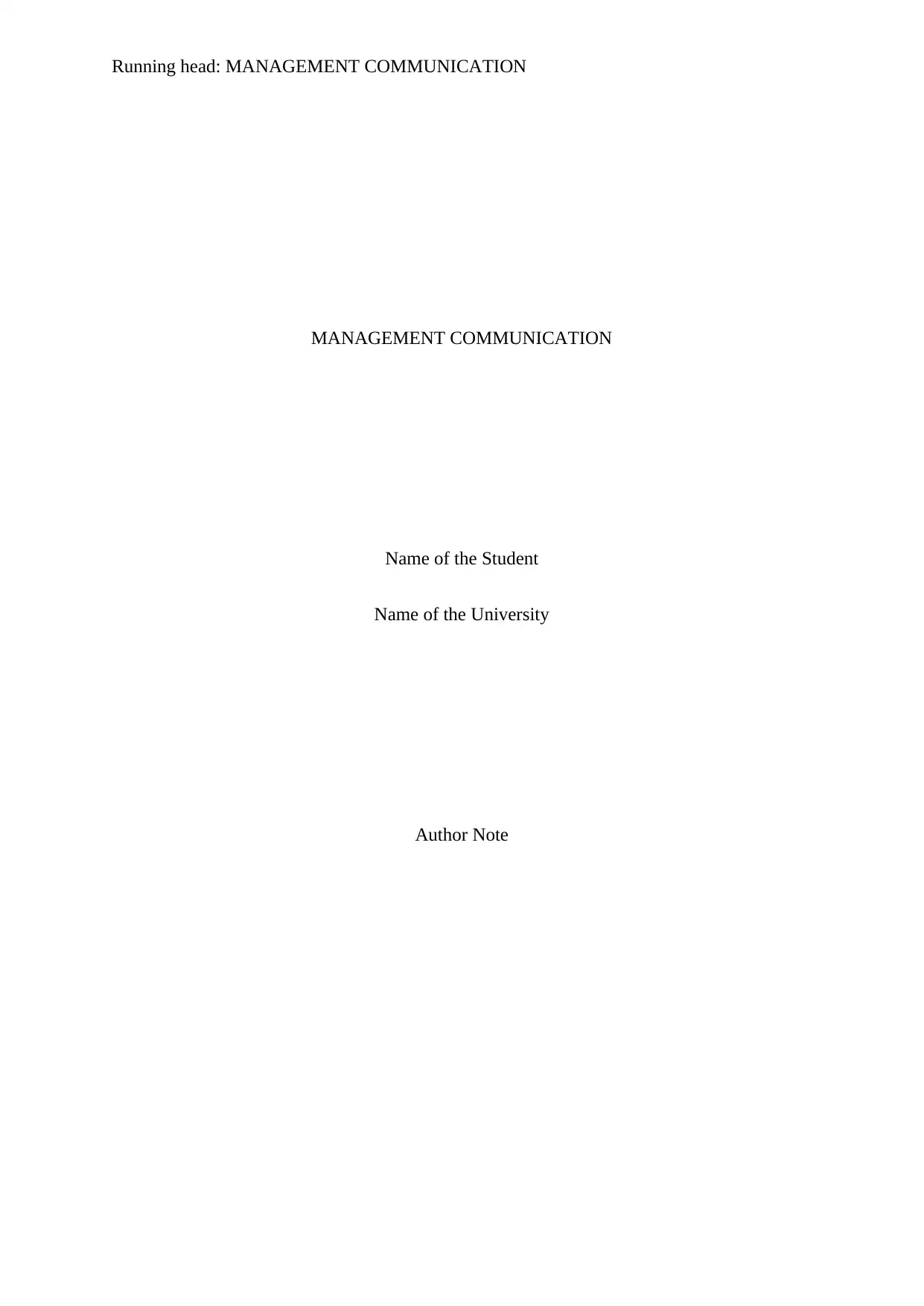
Running head: MANAGEMENT COMMUNICATION
MANAGEMENT COMMUNICATION
Name of the Student
Name of the University
Author Note
MANAGEMENT COMMUNICATION
Name of the Student
Name of the University
Author Note
Secure Best Marks with AI Grader
Need help grading? Try our AI Grader for instant feedback on your assignments.
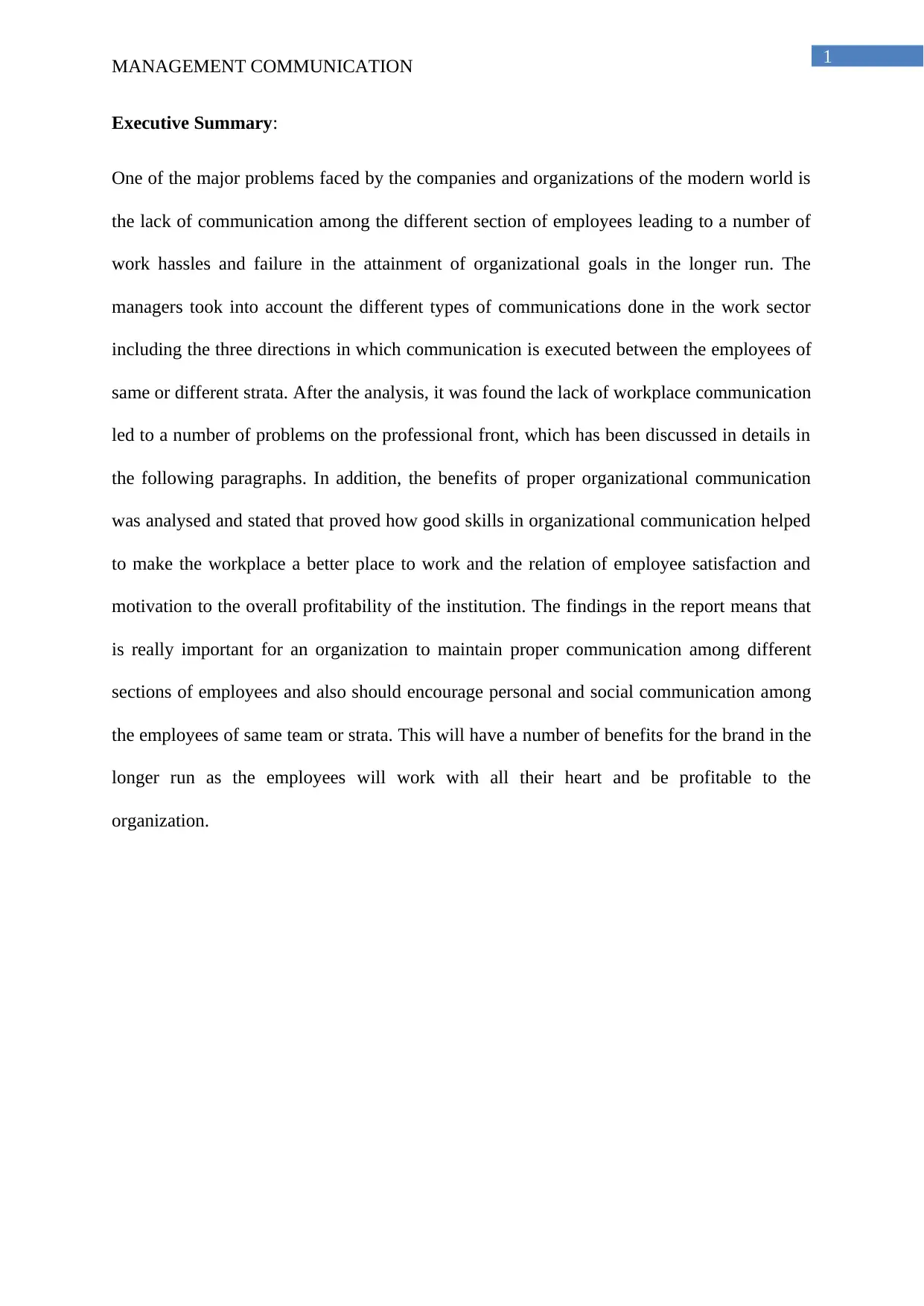
1
MANAGEMENT COMMUNICATION
Executive Summary:
One of the major problems faced by the companies and organizations of the modern world is
the lack of communication among the different section of employees leading to a number of
work hassles and failure in the attainment of organizational goals in the longer run. The
managers took into account the different types of communications done in the work sector
including the three directions in which communication is executed between the employees of
same or different strata. After the analysis, it was found the lack of workplace communication
led to a number of problems on the professional front, which has been discussed in details in
the following paragraphs. In addition, the benefits of proper organizational communication
was analysed and stated that proved how good skills in organizational communication helped
to make the workplace a better place to work and the relation of employee satisfaction and
motivation to the overall profitability of the institution. The findings in the report means that
is really important for an organization to maintain proper communication among different
sections of employees and also should encourage personal and social communication among
the employees of same team or strata. This will have a number of benefits for the brand in the
longer run as the employees will work with all their heart and be profitable to the
organization.
MANAGEMENT COMMUNICATION
Executive Summary:
One of the major problems faced by the companies and organizations of the modern world is
the lack of communication among the different section of employees leading to a number of
work hassles and failure in the attainment of organizational goals in the longer run. The
managers took into account the different types of communications done in the work sector
including the three directions in which communication is executed between the employees of
same or different strata. After the analysis, it was found the lack of workplace communication
led to a number of problems on the professional front, which has been discussed in details in
the following paragraphs. In addition, the benefits of proper organizational communication
was analysed and stated that proved how good skills in organizational communication helped
to make the workplace a better place to work and the relation of employee satisfaction and
motivation to the overall profitability of the institution. The findings in the report means that
is really important for an organization to maintain proper communication among different
sections of employees and also should encourage personal and social communication among
the employees of same team or strata. This will have a number of benefits for the brand in the
longer run as the employees will work with all their heart and be profitable to the
organization.
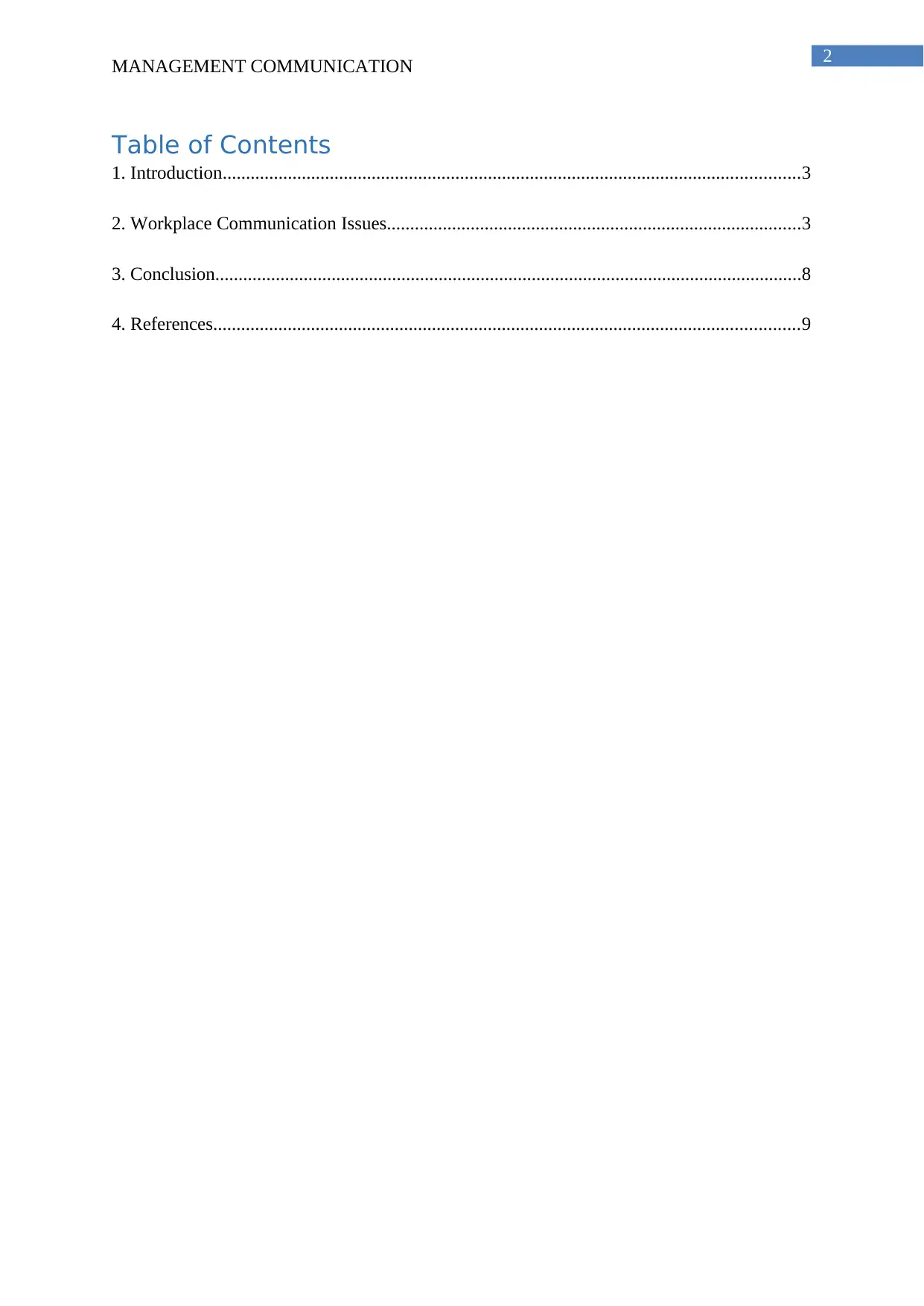
2
MANAGEMENT COMMUNICATION
Table of Contents
1. Introduction............................................................................................................................3
2. Workplace Communication Issues.........................................................................................3
3. Conclusion..............................................................................................................................8
4. References..............................................................................................................................9
MANAGEMENT COMMUNICATION
Table of Contents
1. Introduction............................................................................................................................3
2. Workplace Communication Issues.........................................................................................3
3. Conclusion..............................................................................................................................8
4. References..............................................................................................................................9
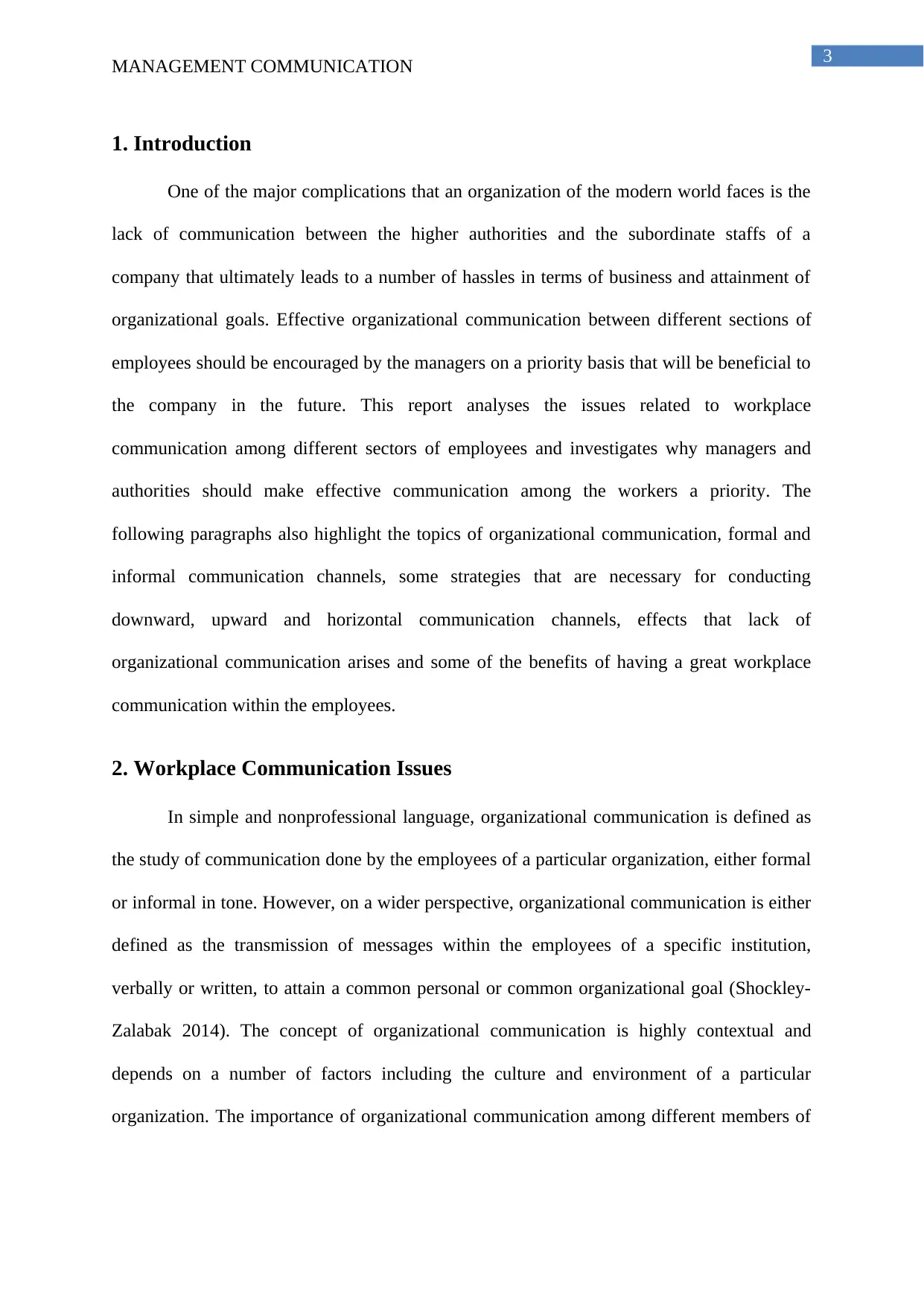
3
MANAGEMENT COMMUNICATION
1. Introduction
One of the major complications that an organization of the modern world faces is the
lack of communication between the higher authorities and the subordinate staffs of a
company that ultimately leads to a number of hassles in terms of business and attainment of
organizational goals. Effective organizational communication between different sections of
employees should be encouraged by the managers on a priority basis that will be beneficial to
the company in the future. This report analyses the issues related to workplace
communication among different sectors of employees and investigates why managers and
authorities should make effective communication among the workers a priority. The
following paragraphs also highlight the topics of organizational communication, formal and
informal communication channels, some strategies that are necessary for conducting
downward, upward and horizontal communication channels, effects that lack of
organizational communication arises and some of the benefits of having a great workplace
communication within the employees.
2. Workplace Communication Issues
In simple and nonprofessional language, organizational communication is defined as
the study of communication done by the employees of a particular organization, either formal
or informal in tone. However, on a wider perspective, organizational communication is either
defined as the transmission of messages within the employees of a specific institution,
verbally or written, to attain a common personal or common organizational goal (Shockley-
Zalabak 2014). The concept of organizational communication is highly contextual and
depends on a number of factors including the culture and environment of a particular
organization. The importance of organizational communication among different members of
MANAGEMENT COMMUNICATION
1. Introduction
One of the major complications that an organization of the modern world faces is the
lack of communication between the higher authorities and the subordinate staffs of a
company that ultimately leads to a number of hassles in terms of business and attainment of
organizational goals. Effective organizational communication between different sections of
employees should be encouraged by the managers on a priority basis that will be beneficial to
the company in the future. This report analyses the issues related to workplace
communication among different sectors of employees and investigates why managers and
authorities should make effective communication among the workers a priority. The
following paragraphs also highlight the topics of organizational communication, formal and
informal communication channels, some strategies that are necessary for conducting
downward, upward and horizontal communication channels, effects that lack of
organizational communication arises and some of the benefits of having a great workplace
communication within the employees.
2. Workplace Communication Issues
In simple and nonprofessional language, organizational communication is defined as
the study of communication done by the employees of a particular organization, either formal
or informal in tone. However, on a wider perspective, organizational communication is either
defined as the transmission of messages within the employees of a specific institution,
verbally or written, to attain a common personal or common organizational goal (Shockley-
Zalabak 2014). The concept of organizational communication is highly contextual and
depends on a number of factors including the culture and environment of a particular
organization. The importance of organizational communication among different members of
Secure Best Marks with AI Grader
Need help grading? Try our AI Grader for instant feedback on your assignments.
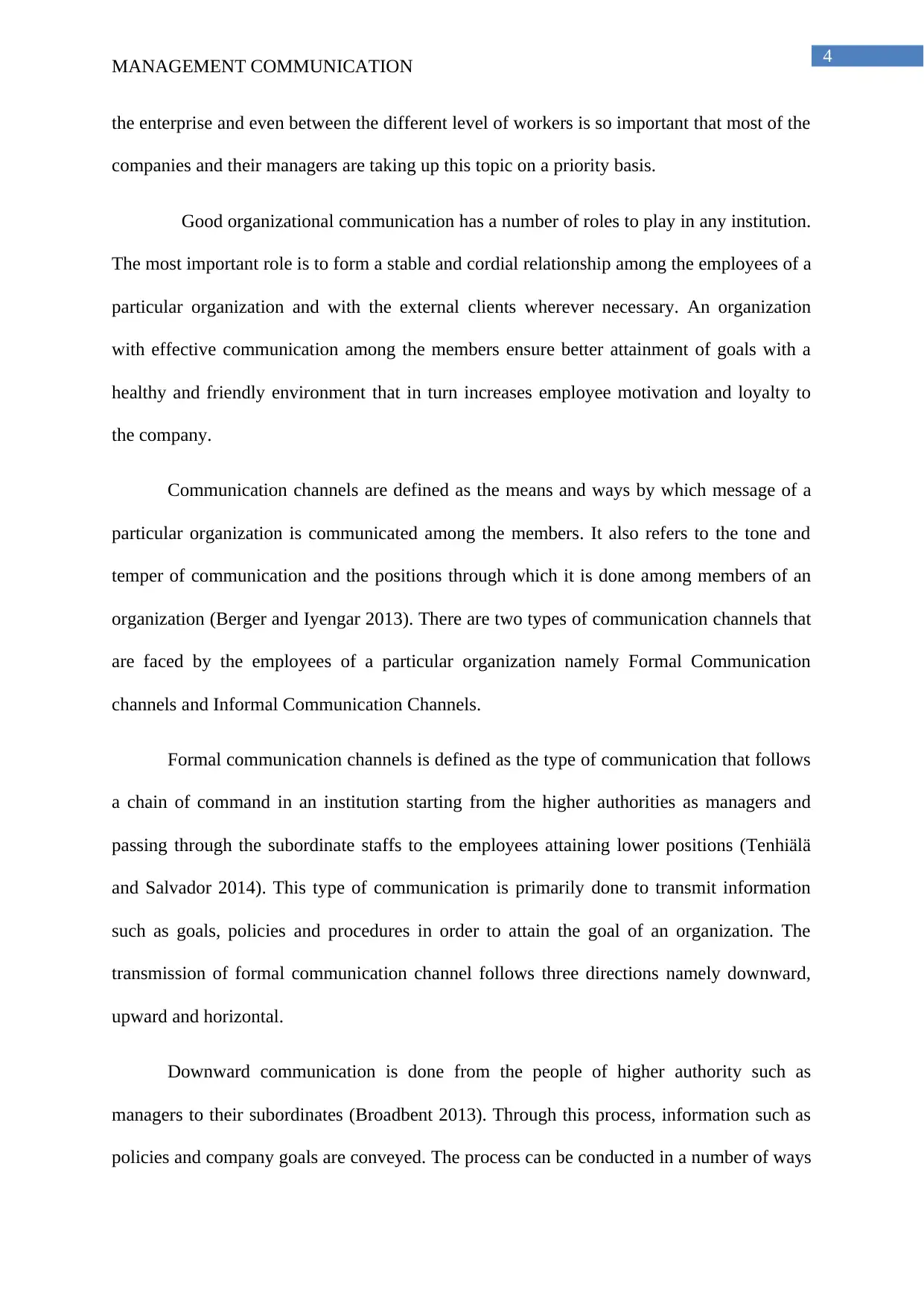
4
MANAGEMENT COMMUNICATION
the enterprise and even between the different level of workers is so important that most of the
companies and their managers are taking up this topic on a priority basis.
Good organizational communication has a number of roles to play in any institution.
The most important role is to form a stable and cordial relationship among the employees of a
particular organization and with the external clients wherever necessary. An organization
with effective communication among the members ensure better attainment of goals with a
healthy and friendly environment that in turn increases employee motivation and loyalty to
the company.
Communication channels are defined as the means and ways by which message of a
particular organization is communicated among the members. It also refers to the tone and
temper of communication and the positions through which it is done among members of an
organization (Berger and Iyengar 2013). There are two types of communication channels that
are faced by the employees of a particular organization namely Formal Communication
channels and Informal Communication Channels.
Formal communication channels is defined as the type of communication that follows
a chain of command in an institution starting from the higher authorities as managers and
passing through the subordinate staffs to the employees attaining lower positions (Tenhiälä
and Salvador 2014). This type of communication is primarily done to transmit information
such as goals, policies and procedures in order to attain the goal of an organization. The
transmission of formal communication channel follows three directions namely downward,
upward and horizontal.
Downward communication is done from the people of higher authority such as
managers to their subordinates (Broadbent 2013). Through this process, information such as
policies and company goals are conveyed. The process can be conducted in a number of ways
MANAGEMENT COMMUNICATION
the enterprise and even between the different level of workers is so important that most of the
companies and their managers are taking up this topic on a priority basis.
Good organizational communication has a number of roles to play in any institution.
The most important role is to form a stable and cordial relationship among the employees of a
particular organization and with the external clients wherever necessary. An organization
with effective communication among the members ensure better attainment of goals with a
healthy and friendly environment that in turn increases employee motivation and loyalty to
the company.
Communication channels are defined as the means and ways by which message of a
particular organization is communicated among the members. It also refers to the tone and
temper of communication and the positions through which it is done among members of an
organization (Berger and Iyengar 2013). There are two types of communication channels that
are faced by the employees of a particular organization namely Formal Communication
channels and Informal Communication Channels.
Formal communication channels is defined as the type of communication that follows
a chain of command in an institution starting from the higher authorities as managers and
passing through the subordinate staffs to the employees attaining lower positions (Tenhiälä
and Salvador 2014). This type of communication is primarily done to transmit information
such as goals, policies and procedures in order to attain the goal of an organization. The
transmission of formal communication channel follows three directions namely downward,
upward and horizontal.
Downward communication is done from the people of higher authority such as
managers to their subordinates (Broadbent 2013). Through this process, information such as
policies and company goals are conveyed. The process can be conducted in a number of ways
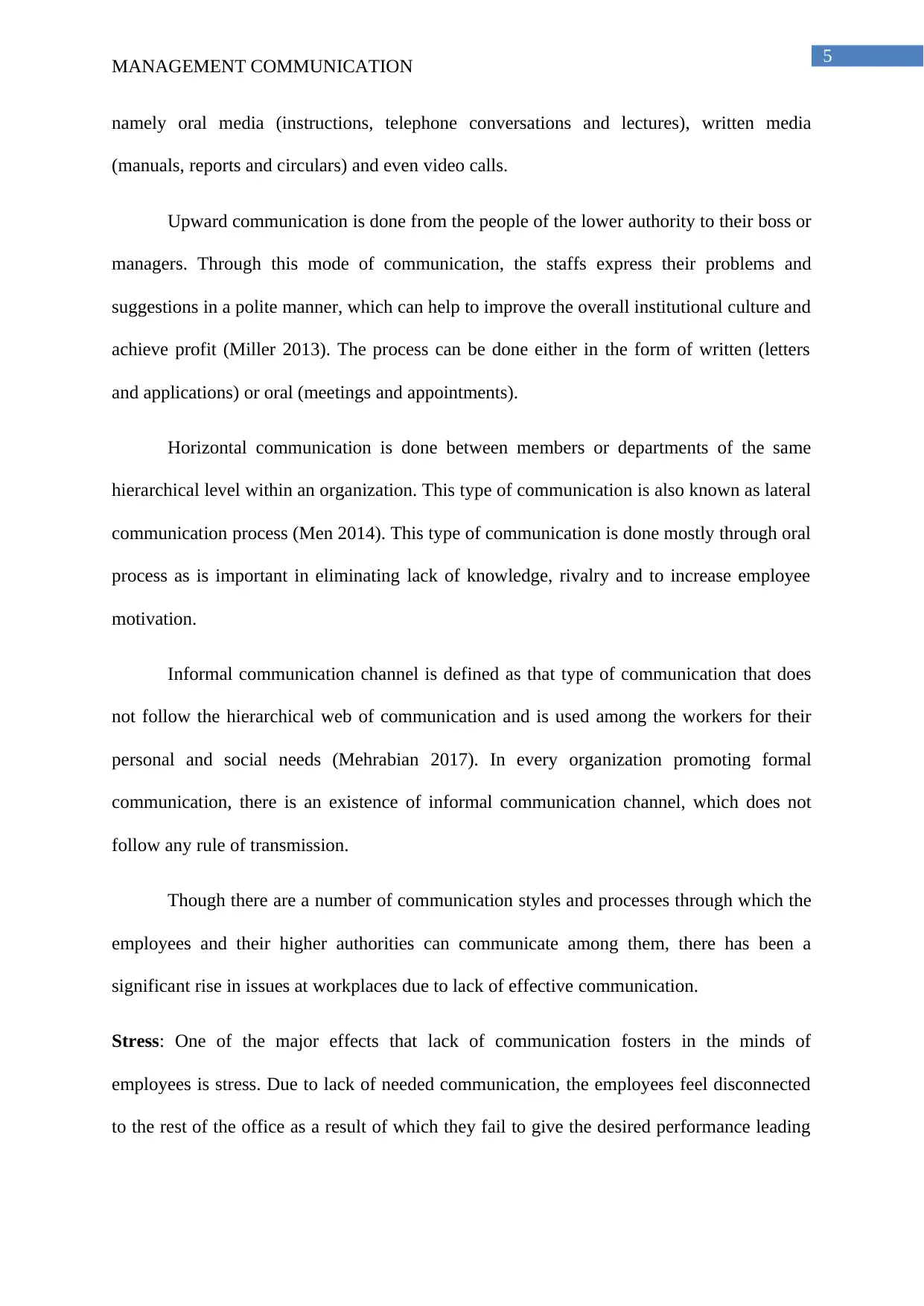
5
MANAGEMENT COMMUNICATION
namely oral media (instructions, telephone conversations and lectures), written media
(manuals, reports and circulars) and even video calls.
Upward communication is done from the people of the lower authority to their boss or
managers. Through this mode of communication, the staffs express their problems and
suggestions in a polite manner, which can help to improve the overall institutional culture and
achieve profit (Miller 2013). The process can be done either in the form of written (letters
and applications) or oral (meetings and appointments).
Horizontal communication is done between members or departments of the same
hierarchical level within an organization. This type of communication is also known as lateral
communication process (Men 2014). This type of communication is done mostly through oral
process as is important in eliminating lack of knowledge, rivalry and to increase employee
motivation.
Informal communication channel is defined as that type of communication that does
not follow the hierarchical web of communication and is used among the workers for their
personal and social needs (Mehrabian 2017). In every organization promoting formal
communication, there is an existence of informal communication channel, which does not
follow any rule of transmission.
Though there are a number of communication styles and processes through which the
employees and their higher authorities can communicate among them, there has been a
significant rise in issues at workplaces due to lack of effective communication.
Stress: One of the major effects that lack of communication fosters in the minds of
employees is stress. Due to lack of needed communication, the employees feel disconnected
to the rest of the office as a result of which they fail to give the desired performance leading
MANAGEMENT COMMUNICATION
namely oral media (instructions, telephone conversations and lectures), written media
(manuals, reports and circulars) and even video calls.
Upward communication is done from the people of the lower authority to their boss or
managers. Through this mode of communication, the staffs express their problems and
suggestions in a polite manner, which can help to improve the overall institutional culture and
achieve profit (Miller 2013). The process can be done either in the form of written (letters
and applications) or oral (meetings and appointments).
Horizontal communication is done between members or departments of the same
hierarchical level within an organization. This type of communication is also known as lateral
communication process (Men 2014). This type of communication is done mostly through oral
process as is important in eliminating lack of knowledge, rivalry and to increase employee
motivation.
Informal communication channel is defined as that type of communication that does
not follow the hierarchical web of communication and is used among the workers for their
personal and social needs (Mehrabian 2017). In every organization promoting formal
communication, there is an existence of informal communication channel, which does not
follow any rule of transmission.
Though there are a number of communication styles and processes through which the
employees and their higher authorities can communicate among them, there has been a
significant rise in issues at workplaces due to lack of effective communication.
Stress: One of the major effects that lack of communication fosters in the minds of
employees is stress. Due to lack of needed communication, the employees feel disconnected
to the rest of the office as a result of which they fail to give the desired performance leading
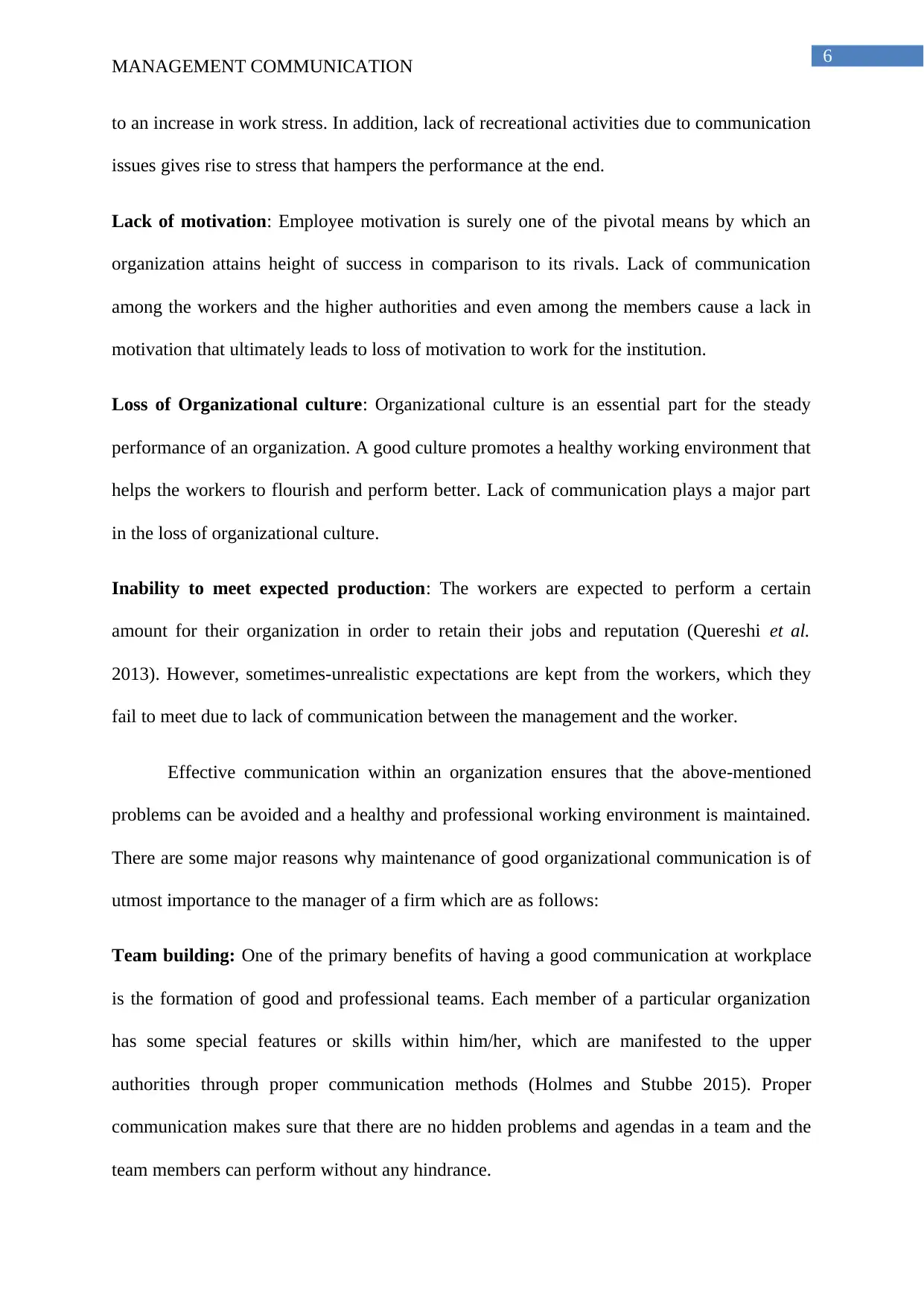
6
MANAGEMENT COMMUNICATION
to an increase in work stress. In addition, lack of recreational activities due to communication
issues gives rise to stress that hampers the performance at the end.
Lack of motivation: Employee motivation is surely one of the pivotal means by which an
organization attains height of success in comparison to its rivals. Lack of communication
among the workers and the higher authorities and even among the members cause a lack in
motivation that ultimately leads to loss of motivation to work for the institution.
Loss of Organizational culture: Organizational culture is an essential part for the steady
performance of an organization. A good culture promotes a healthy working environment that
helps the workers to flourish and perform better. Lack of communication plays a major part
in the loss of organizational culture.
Inability to meet expected production: The workers are expected to perform a certain
amount for their organization in order to retain their jobs and reputation (Quereshi et al.
2013). However, sometimes-unrealistic expectations are kept from the workers, which they
fail to meet due to lack of communication between the management and the worker.
Effective communication within an organization ensures that the above-mentioned
problems can be avoided and a healthy and professional working environment is maintained.
There are some major reasons why maintenance of good organizational communication is of
utmost importance to the manager of a firm which are as follows:
Team building: One of the primary benefits of having a good communication at workplace
is the formation of good and professional teams. Each member of a particular organization
has some special features or skills within him/her, which are manifested to the upper
authorities through proper communication methods (Holmes and Stubbe 2015). Proper
communication makes sure that there are no hidden problems and agendas in a team and the
team members can perform without any hindrance.
MANAGEMENT COMMUNICATION
to an increase in work stress. In addition, lack of recreational activities due to communication
issues gives rise to stress that hampers the performance at the end.
Lack of motivation: Employee motivation is surely one of the pivotal means by which an
organization attains height of success in comparison to its rivals. Lack of communication
among the workers and the higher authorities and even among the members cause a lack in
motivation that ultimately leads to loss of motivation to work for the institution.
Loss of Organizational culture: Organizational culture is an essential part for the steady
performance of an organization. A good culture promotes a healthy working environment that
helps the workers to flourish and perform better. Lack of communication plays a major part
in the loss of organizational culture.
Inability to meet expected production: The workers are expected to perform a certain
amount for their organization in order to retain their jobs and reputation (Quereshi et al.
2013). However, sometimes-unrealistic expectations are kept from the workers, which they
fail to meet due to lack of communication between the management and the worker.
Effective communication within an organization ensures that the above-mentioned
problems can be avoided and a healthy and professional working environment is maintained.
There are some major reasons why maintenance of good organizational communication is of
utmost importance to the manager of a firm which are as follows:
Team building: One of the primary benefits of having a good communication at workplace
is the formation of good and professional teams. Each member of a particular organization
has some special features or skills within him/her, which are manifested to the upper
authorities through proper communication methods (Holmes and Stubbe 2015). Proper
communication makes sure that there are no hidden problems and agendas in a team and the
team members can perform without any hindrance.
Paraphrase This Document
Need a fresh take? Get an instant paraphrase of this document with our AI Paraphraser
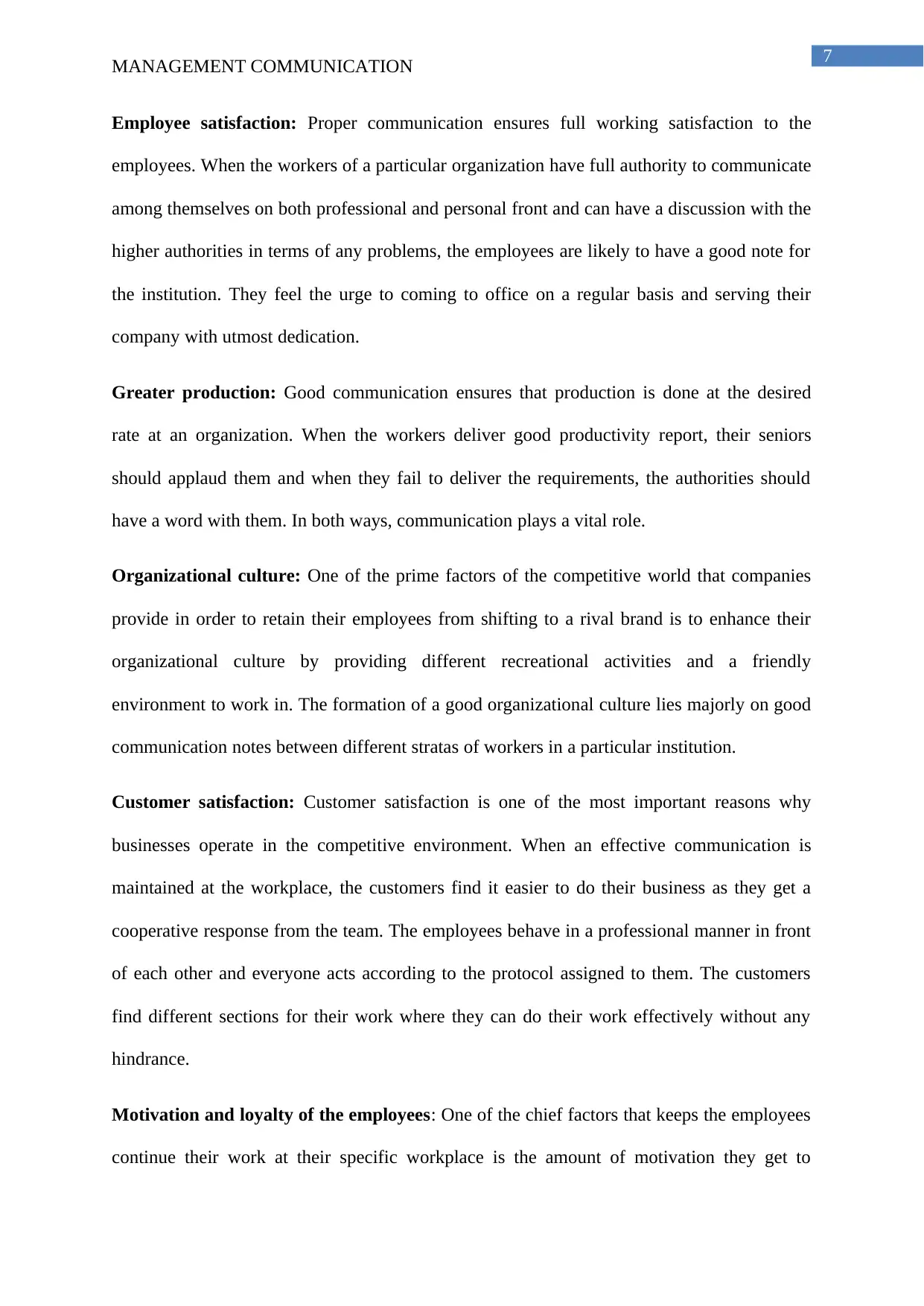
7
MANAGEMENT COMMUNICATION
Employee satisfaction: Proper communication ensures full working satisfaction to the
employees. When the workers of a particular organization have full authority to communicate
among themselves on both professional and personal front and can have a discussion with the
higher authorities in terms of any problems, the employees are likely to have a good note for
the institution. They feel the urge to coming to office on a regular basis and serving their
company with utmost dedication.
Greater production: Good communication ensures that production is done at the desired
rate at an organization. When the workers deliver good productivity report, their seniors
should applaud them and when they fail to deliver the requirements, the authorities should
have a word with them. In both ways, communication plays a vital role.
Organizational culture: One of the prime factors of the competitive world that companies
provide in order to retain their employees from shifting to a rival brand is to enhance their
organizational culture by providing different recreational activities and a friendly
environment to work in. The formation of a good organizational culture lies majorly on good
communication notes between different stratas of workers in a particular institution.
Customer satisfaction: Customer satisfaction is one of the most important reasons why
businesses operate in the competitive environment. When an effective communication is
maintained at the workplace, the customers find it easier to do their business as they get a
cooperative response from the team. The employees behave in a professional manner in front
of each other and everyone acts according to the protocol assigned to them. The customers
find different sections for their work where they can do their work effectively without any
hindrance.
Motivation and loyalty of the employees: One of the chief factors that keeps the employees
continue their work at their specific workplace is the amount of motivation they get to
MANAGEMENT COMMUNICATION
Employee satisfaction: Proper communication ensures full working satisfaction to the
employees. When the workers of a particular organization have full authority to communicate
among themselves on both professional and personal front and can have a discussion with the
higher authorities in terms of any problems, the employees are likely to have a good note for
the institution. They feel the urge to coming to office on a regular basis and serving their
company with utmost dedication.
Greater production: Good communication ensures that production is done at the desired
rate at an organization. When the workers deliver good productivity report, their seniors
should applaud them and when they fail to deliver the requirements, the authorities should
have a word with them. In both ways, communication plays a vital role.
Organizational culture: One of the prime factors of the competitive world that companies
provide in order to retain their employees from shifting to a rival brand is to enhance their
organizational culture by providing different recreational activities and a friendly
environment to work in. The formation of a good organizational culture lies majorly on good
communication notes between different stratas of workers in a particular institution.
Customer satisfaction: Customer satisfaction is one of the most important reasons why
businesses operate in the competitive environment. When an effective communication is
maintained at the workplace, the customers find it easier to do their business as they get a
cooperative response from the team. The employees behave in a professional manner in front
of each other and everyone acts according to the protocol assigned to them. The customers
find different sections for their work where they can do their work effectively without any
hindrance.
Motivation and loyalty of the employees: One of the chief factors that keeps the employees
continue their work at their specific workplace is the amount of motivation they get to
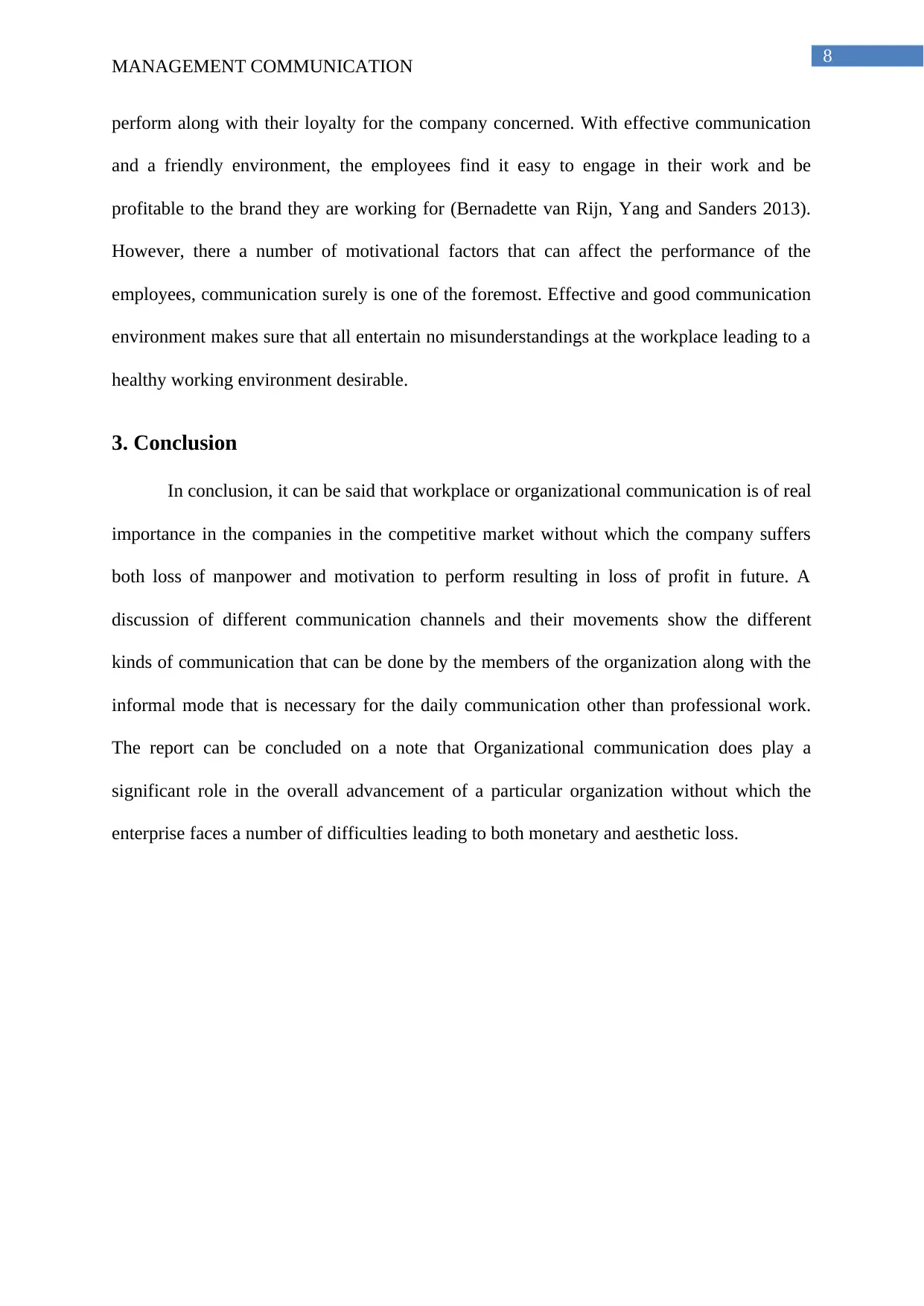
8
MANAGEMENT COMMUNICATION
perform along with their loyalty for the company concerned. With effective communication
and a friendly environment, the employees find it easy to engage in their work and be
profitable to the brand they are working for (Bernadette van Rijn, Yang and Sanders 2013).
However, there a number of motivational factors that can affect the performance of the
employees, communication surely is one of the foremost. Effective and good communication
environment makes sure that all entertain no misunderstandings at the workplace leading to a
healthy working environment desirable.
3. Conclusion
In conclusion, it can be said that workplace or organizational communication is of real
importance in the companies in the competitive market without which the company suffers
both loss of manpower and motivation to perform resulting in loss of profit in future. A
discussion of different communication channels and their movements show the different
kinds of communication that can be done by the members of the organization along with the
informal mode that is necessary for the daily communication other than professional work.
The report can be concluded on a note that Organizational communication does play a
significant role in the overall advancement of a particular organization without which the
enterprise faces a number of difficulties leading to both monetary and aesthetic loss.
MANAGEMENT COMMUNICATION
perform along with their loyalty for the company concerned. With effective communication
and a friendly environment, the employees find it easy to engage in their work and be
profitable to the brand they are working for (Bernadette van Rijn, Yang and Sanders 2013).
However, there a number of motivational factors that can affect the performance of the
employees, communication surely is one of the foremost. Effective and good communication
environment makes sure that all entertain no misunderstandings at the workplace leading to a
healthy working environment desirable.
3. Conclusion
In conclusion, it can be said that workplace or organizational communication is of real
importance in the companies in the competitive market without which the company suffers
both loss of manpower and motivation to perform resulting in loss of profit in future. A
discussion of different communication channels and their movements show the different
kinds of communication that can be done by the members of the organization along with the
informal mode that is necessary for the daily communication other than professional work.
The report can be concluded on a note that Organizational communication does play a
significant role in the overall advancement of a particular organization without which the
enterprise faces a number of difficulties leading to both monetary and aesthetic loss.
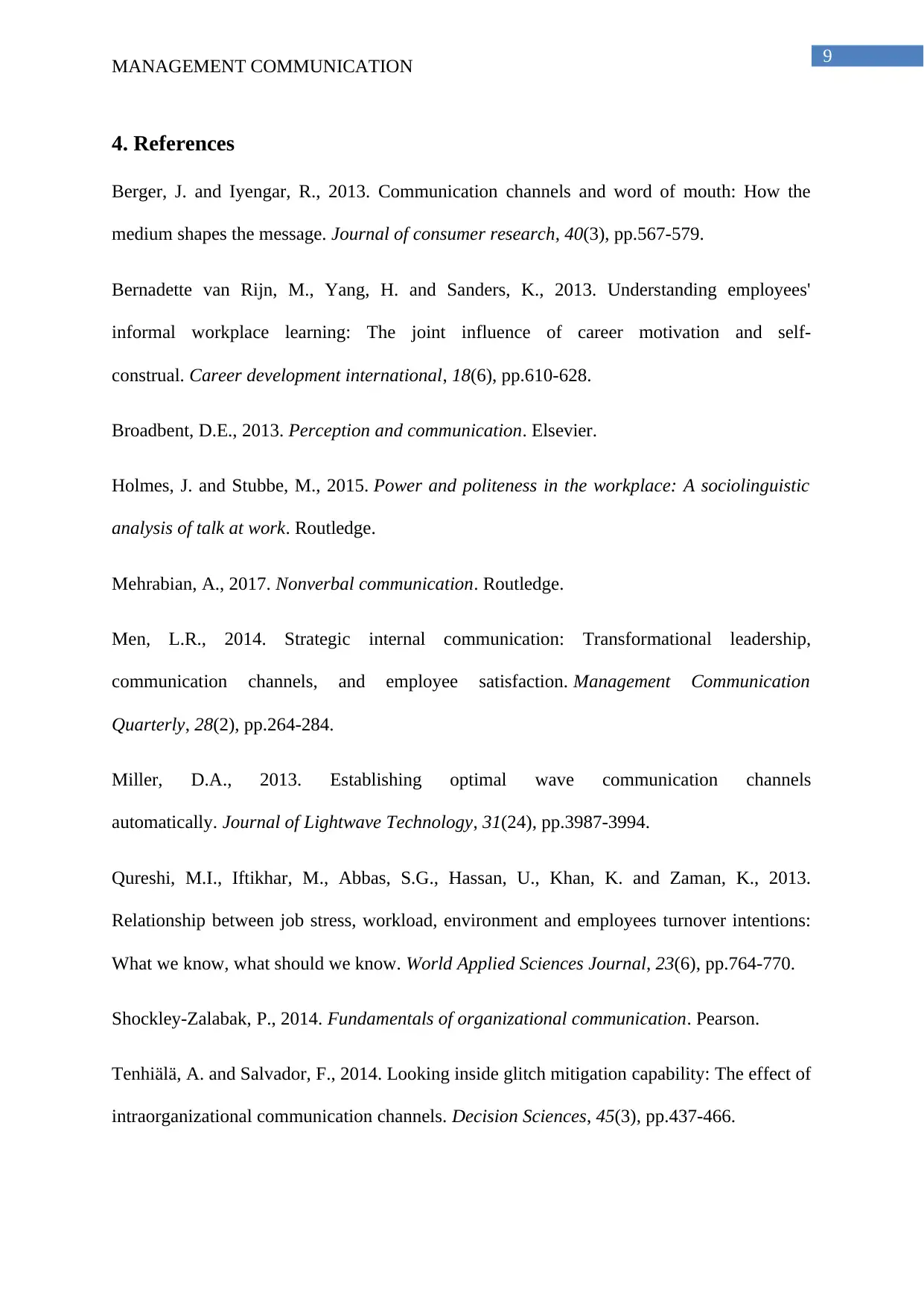
9
MANAGEMENT COMMUNICATION
4. References
Berger, J. and Iyengar, R., 2013. Communication channels and word of mouth: How the
medium shapes the message. Journal of consumer research, 40(3), pp.567-579.
Bernadette van Rijn, M., Yang, H. and Sanders, K., 2013. Understanding employees'
informal workplace learning: The joint influence of career motivation and self-
construal. Career development international, 18(6), pp.610-628.
Broadbent, D.E., 2013. Perception and communication. Elsevier.
Holmes, J. and Stubbe, M., 2015. Power and politeness in the workplace: A sociolinguistic
analysis of talk at work. Routledge.
Mehrabian, A., 2017. Nonverbal communication. Routledge.
Men, L.R., 2014. Strategic internal communication: Transformational leadership,
communication channels, and employee satisfaction. Management Communication
Quarterly, 28(2), pp.264-284.
Miller, D.A., 2013. Establishing optimal wave communication channels
automatically. Journal of Lightwave Technology, 31(24), pp.3987-3994.
Qureshi, M.I., Iftikhar, M., Abbas, S.G., Hassan, U., Khan, K. and Zaman, K., 2013.
Relationship between job stress, workload, environment and employees turnover intentions:
What we know, what should we know. World Applied Sciences Journal, 23(6), pp.764-770.
Shockley-Zalabak, P., 2014. Fundamentals of organizational communication. Pearson.
Tenhiälä, A. and Salvador, F., 2014. Looking inside glitch mitigation capability: The effect of
intraorganizational communication channels. Decision Sciences, 45(3), pp.437-466.
MANAGEMENT COMMUNICATION
4. References
Berger, J. and Iyengar, R., 2013. Communication channels and word of mouth: How the
medium shapes the message. Journal of consumer research, 40(3), pp.567-579.
Bernadette van Rijn, M., Yang, H. and Sanders, K., 2013. Understanding employees'
informal workplace learning: The joint influence of career motivation and self-
construal. Career development international, 18(6), pp.610-628.
Broadbent, D.E., 2013. Perception and communication. Elsevier.
Holmes, J. and Stubbe, M., 2015. Power and politeness in the workplace: A sociolinguistic
analysis of talk at work. Routledge.
Mehrabian, A., 2017. Nonverbal communication. Routledge.
Men, L.R., 2014. Strategic internal communication: Transformational leadership,
communication channels, and employee satisfaction. Management Communication
Quarterly, 28(2), pp.264-284.
Miller, D.A., 2013. Establishing optimal wave communication channels
automatically. Journal of Lightwave Technology, 31(24), pp.3987-3994.
Qureshi, M.I., Iftikhar, M., Abbas, S.G., Hassan, U., Khan, K. and Zaman, K., 2013.
Relationship between job stress, workload, environment and employees turnover intentions:
What we know, what should we know. World Applied Sciences Journal, 23(6), pp.764-770.
Shockley-Zalabak, P., 2014. Fundamentals of organizational communication. Pearson.
Tenhiälä, A. and Salvador, F., 2014. Looking inside glitch mitigation capability: The effect of
intraorganizational communication channels. Decision Sciences, 45(3), pp.437-466.
1 out of 10
Related Documents
Your All-in-One AI-Powered Toolkit for Academic Success.
+13062052269
info@desklib.com
Available 24*7 on WhatsApp / Email
![[object Object]](/_next/static/media/star-bottom.7253800d.svg)
Unlock your academic potential
© 2024 | Zucol Services PVT LTD | All rights reserved.



